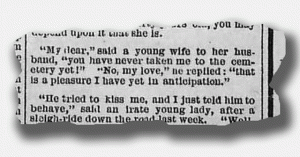Humorous content: Patience, my dear…
February 28, 2009 by TimHughes · Leave a Comment
A brief bit in the “Ocean Chronicle” newspaper of February 14, 1887 reads:
” ‘My dear’, said a young wife to her husband, ‘you have never taken me to the cemetery yet!’ ‘No, my love,’ he replied: ‘that is a pleasure I have yet in anticipation.’ “
No comments necessary. 🙂
Rare newspaper collector’s inspiring story…
February 26, 2009 by GuyHeilenman · Leave a Comment
Over the years we have had the opportunity to establish relationships with many wonderful people within the rare newspapers community. On occasion, we are blessed to hear about the story behind the voice on the other end of the phone. One such person is Robert (Bob) Cassidy, of Pekin, Illinois. He is one of those individuals whom always has something positive to say, and who manages to make everyone he speaks with feel important. What a gift. This gift is especailly noteworthy considering the health issues he must hurdle in order to communicate. It is obvious he is a man of strong character, and of even stronger faith. It is the combination of both traits which provide the backdrop for… his story:
Disease inspires man to paint…
(Source: The Journal Star by Elise Zwicky)
“For some, a diagnosis of Parkinson’s disease might end an art career; for Bob Cassidy, it was the catalyst for getting started. ‘God, in his infinite wisdom, gave me Parkinson’s to see if I still had a sense of humor. And I did, thank God,’ said the 73-year-old retired speech specialist. Cassidy is planning an open house at the end of February or early March at his new art studio…” (read more)
Thanks Bob. You are an inspiration to us all.
Coffee House newspapers: a brief history…
February 26, 2009 by TimHughes · 2 Comments
 A number of titles on our website are referred to as “coffee house newspapers” with little explanation as to what they are. I think we owe our customers a bit of history on this interesting era.
A number of titles on our website are referred to as “coffee house newspapers” with little explanation as to what they are. I think we owe our customers a bit of history on this interesting era.
During most of the 17th century newspaper publishing was very heavily regulated. All printing offices in England were under the control of the Surveyor of the Imprimery, or Press. Roger L’Estrange held the position in the latter half of the century and had the sole privilege of writing, printing & publishing newspapers, being involved in the “Intelligencer”, “The News”, the “City Mercury” and the “Observator“. His monopoly was broken in 1665 with the creation of the “Oxford Gazette”, renamed the “London Gazette” when it removed there after 23 issues in Oxford.
With the arrival of William of Orange in 1689 came a reduction of state control over the press. This new-found freedom gave the independent press a real impetus. Readers’ interests widened. Politics & religion were no longer everyone’s cup of tea, for it was in the post-1689 years that the coffee house as a meeting place for exchanging merchandise & ideas came into its own. Newspapers provided stimulus for conversations and gossip & entertainment became accepted & then demanded.
The London coffee-houses provided a gathering place where any man who was reasonably dressed could smoke his long, clay pipe, sip his coffee, read the newsletters of the day, or enter into conversation with other patrons. At this period when journalism was in its infancy and the postal system was unorganized and irregular, the coffee-house provided a center of communication for news and information. Runners were sent round to the coffee house to report major events of the day, such as victory in battle or political upheaval, and the newsletters and gazettes of the day were distributed chiefly in the coffee house. Most of the establishments functioned as reading rooms. In addition, bulletins announcing sales, sailings, and auctions covered the walls of the establishments, providing valuable information to the businessman who conducted much of his business from a table at his favorite coffee house.
During thie era, particularly the early years of the 18th century, newspapers such as the “Tatler“, “Spectator“, “Guardian” “Athenian Mercury” & “Rehearsal” among others were very much in vogue in the coffee houses, and were more dialogue in format with back & forth discussion of a specific topic rather than reporting of news of the day.
By the latter half of the 18th century coffee house culture had run its course, but left in its wake much interesting literary work by some notable names including Daniel DeFoe (wrote for “A Review Of The State Of The Nation“, Joseph Addison & Richard Steele among others. Newspaper format tended more towards reporting news events of the day with presses being established outside the boundaries of London as well as increased activity within the city. One of the more successful titles which flourished in the latter half of the 1700’s was the “London Chronicle“, many issues of which we offer on our website, catalogs and supplements.
The first newspaper in Utah…
February 23, 2009 by TimHughes · 2 Comments
There was a great migration to the West in 1847, just two years before a more historic wave of travelers prompted by the California gold rush, when about 2000 Mormons crossed the western plains seeking a location in which they could peacefully follow their religion. Led by Brigham Young, among the many items they included on their journey was a printing press purchased in Philadelphia.
What is now Utah belonged to Mexico in 1847 but the Mexican War, ongoing in 1847, would result in the 1848 treaty which would pass ownership to the United States. But since federal authorities never established a system of government for this new land, the Mormons took matters into their own hands and in 1849 organized the “State of Deseret” (land of the honey bee) with Brigham Young as governor.
 Volume one, number one of the DESERET NEWS newspaper, an eight page newspaper just 8 by 10 1/2 inches, appeared in Salt Lake on June 15, 1850 making it the very first newspaper published in Utah. It printed for just over one year before it was suspended for several months for lack of paper. Begun as a weekly, after just four months it became a semimonthly but returned as a weekly in 1854. Conditions for printing were harsh and crude so far from the more settled areas of the country over 1000 miles to the east.
Volume one, number one of the DESERET NEWS newspaper, an eight page newspaper just 8 by 10 1/2 inches, appeared in Salt Lake on June 15, 1850 making it the very first newspaper published in Utah. It printed for just over one year before it was suspended for several months for lack of paper. Begun as a weekly, after just four months it became a semimonthly but returned as a weekly in 1854. Conditions for printing were harsh and crude so far from the more settled areas of the country over 1000 miles to the east.
We are pleased to share with our collectors the August 17, 1850 issue of the DESERET NEWS from our private collection, just the tenth number printed.
A Bizarre Report: Maybe she was angry about her name…
February 21, 2009 by TimHughes · Leave a Comment
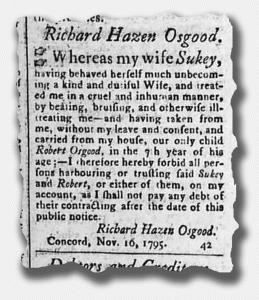 The “Courier of New Hampshire” newspaper from Concord, Nov. 21, 1795 has a page 3 item:
The “Courier of New Hampshire” newspaper from Concord, Nov. 21, 1795 has a page 3 item:
“Whereas my wife Sukey, having behaved herself much unbecoming a kind and dutiful Wife, and treated me in a cruel and inhuman manner, by beating, bruising, and otherwise ill-treating me–and having taken from me, without my leave and consent, and carried from my house our only child Robert Osgood, in the 7th year of his age; I therefore hereby forbid any persons harbouring or trusting said Sukey and Robert, or either of them, on my account, as I shall not pay any debt of their contracting after the date of this public notice.”
Removing old newspapers from bound volumes (disbinding)…
February 19, 2009 by TimHughes · 3 Comments
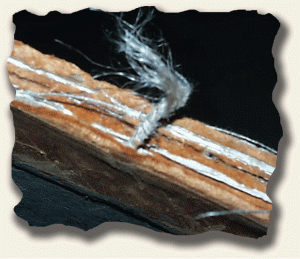 At some point along your collecting journey you may have purchased a bound volume because a particular issue was of interest, not the entire lot of 100 or more found within. Perhaps you’ve given though to taking the volume apart to secure that single issue but were afraid to cause damage. It can be done and with some practice you can find the process that works best for your particular volume.
At some point along your collecting journey you may have purchased a bound volume because a particular issue was of interest, not the entire lot of 100 or more found within. Perhaps you’ve given though to taking the volume apart to secure that single issue but were afraid to cause damage. It can be done and with some practice you can find the process that works best for your particular volume.
There were hundreds of ways newspapers were bound and each requires a personalized approach, but in general almost all have glue at the spine with various strings interwoven among the various issues. Most 18th & 19th century volumes used glue which is water soluble so Ideally it’s good to apply warm water to the exposed spine (scrape off as much of the leather as possible) and as the glue softens, scrape it off. This can take 30 minutes or more so it requires some patience. It may leave minor evidence of of water staining at the spine but the alternative of not removing glue is often leaving chunks of the spine with volume which is much more damaging.
Then use an exacto-type knife and cut as many of the strings as possible. Typically there are 4 or 5 cords running across the width of the spine around which the smaller strings, which run lengthwise down the volume, are wound. Cut at both sides of these cords and it will fall away. Then carefully lift each issue and “peel” them off much like pages of a tablet, keeping the knife handy to cut strings as they become more exposed.
 Typically the first several issues will have some damage at the spine but the remaining issues should remove more cleanly as you get the knack of the process. Best to start work on the issues as far removed from the issue you are wanting so that by time you get to your special issue you’ll have the experimenting work behind you.
Typically the first several issues will have some damage at the spine but the remaining issues should remove more cleanly as you get the knack of the process. Best to start work on the issues as far removed from the issue you are wanting so that by time you get to your special issue you’ll have the experimenting work behind you.
Twentieth century volumes are more problematic in that the glue is often not water soluble so softening & scraping away the glue may not be an option, but give it a try anyway. In such cases be as diligent as possible in cutting the strings, and as each issue reveals itself in the “peeling away” process you’ll discover the process of how the volume was bound & consequently the tricks of how best to remove the remaining issues with little or no damage.
Bound or unbound: what’s the difference?
February 17, 2009 by TimHughes · 3 Comments
Many of our listings include a comment “never bound nor trimmed” and you may have wondered what that meant, or what the alternative might be. The alternative is what is mostly found in the market of early newspapers today: issues which have been “disbound” with trimmed margins.
 For hundreds of years it was common practice for institutions, typically libraries and historical societies, to maintain a complete set of newspapers which were within their scope of interest, commonly the locally published newspaper. And to make such storage easy so patrons could easily access issues of a specific year, newspapers were gathered together and bound into what was essentially a large book, typically 3, 6 or possibly 12 months to the volume depending on the number of pages per issue. The New York Times and other dailies of the mid-20th century bound just 15 issues per volume.
For hundreds of years it was common practice for institutions, typically libraries and historical societies, to maintain a complete set of newspapers which were within their scope of interest, commonly the locally published newspaper. And to make such storage easy so patrons could easily access issues of a specific year, newspapers were gathered together and bound into what was essentially a large book, typically 3, 6 or possibly 12 months to the volume depending on the number of pages per issue. The New York Times and other dailies of the mid-20th century bound just 15 issues per volume.
When microfilming became popular in the 1950’s institutions found this alternative a dramatic improvement over the “hard copy”, as microfilm took considerably less space, was much easier to handle, and easier to access the specific date or article needed. As a result, institutions “deaccessioned”, or got rid of the heavy, dusty volumes in favor of microfilm causing huge quantities of newspapers to come on the market. I would guess 98% of the early newspapers available today came from such bound volumes, as they can be carefully disbound, returning the newspapers once again to single-issue status. But with most institutions having already gone through this deaccessioning process, volumes of newspapers are getting increasingly difficult to find.
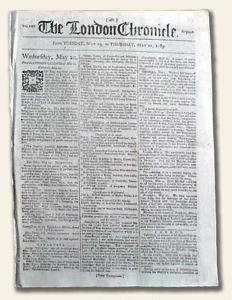 In the binding process, much like the book binding process, the edges of the newspapers were trimmed with a guillotine cutter causing all 3 exposed edges to be neat & uniform. If a few of the newspapers were not neatly bound into their proper location some of the text might be lost when the volume was trimmed. You may have a few such issues in your collection.
In the binding process, much like the book binding process, the edges of the newspapers were trimmed with a guillotine cutter causing all 3 exposed edges to be neat & uniform. If a few of the newspapers were not neatly bound into their proper location some of the text might be lost when the volume was trimmed. You may have a few such issues in your collection.
This process explains why so many newspapers 100+ years old might look in near mint condition without a fold & with straight, even edges. They have been protected within the volume and likely sat on a shelf for over 100 years without being touched by human hands. Such issues are nice additions to newspaper collections.
But lucky is the person who is able to find a newspaper purchased off the street so many years ago and put away until being discovered, avoiding the binding and trimming process. The margins will be wider and most 8 page issues fold out to be one huge sheet of newspaper. Typically the downside to such issues is they are more heavily worn not having been protected within a bound volume, exposed to the elements, and typically handled much more frequently through the years.
In my opinion a never-bound, untrimmed issue would be preferable to a bound & trimmed issue as they are definitely more rare and exhibit their natural state as sold on the the date of issue. Finding such an issue in nice, clean condition is the best of both worlds, but condition is usually the trade-off: if you want your issues to be beautiful and clean, you’ll have more luck with disbound issues; if you want your issues to be “as issued” you’ll likely have to accept wear, soiling and ruffled margins.
How do you deal with the disbound or never-bound dilemma for issues going into your collection?
An Interview with Timothy Hughes…
February 16, 2009 by GuyHeilenman · 1 Comment
 BakerTowne Collectibles recently filmed an interview with Tim Hughes on their Collectibles Corner TV website. Tim appears about midway through the show at the 4:38 time stamp. Once the program fully loads you can drag the time tracker to this spot; however, if you have the time, Tammy’s (the host) entire program is enjoyable to view.
BakerTowne Collectibles recently filmed an interview with Tim Hughes on their Collectibles Corner TV website. Tim appears about midway through the show at the 4:38 time stamp. Once the program fully loads you can drag the time tracker to this spot; however, if you have the time, Tammy’s (the host) entire program is enjoyable to view.
The interview may be found at: http://www.collectiblescornertv.com/?p=114; even better, view the interview below.
Thanks Tammy for your addition to the Rare Newspapers Community.
Stepping back: old catalogs show amazing prices…
February 12, 2009 by TimHughes · 3 Comments
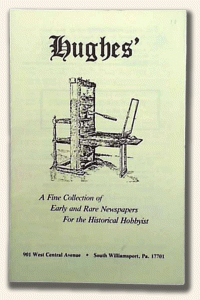 Being a collector, it is no surprise that I have kept at least one copy of every catalog we’ve published from the very first in 1976. I find it interesting to occasionally pull an old catalog off the shelf and browse through the offerings and marvel at some of the prices. They were competitive at the time. Although we emphasize collecting newspapers for the sake of collecting, as there is never a guarantee values will increase by the year, some old listings reflect some amazing prices.
Being a collector, it is no surprise that I have kept at least one copy of every catalog we’ve published from the very first in 1976. I find it interesting to occasionally pull an old catalog off the shelf and browse through the offerings and marvel at some of the prices. They were competitive at the time. Although we emphasize collecting newspapers for the sake of collecting, as there is never a guarantee values will increase by the year, some old listings reflect some amazing prices.
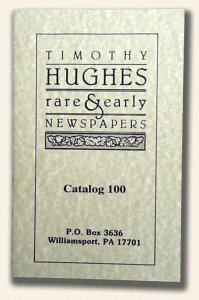 Catalog 77 was issued in early 1990. At that time our catalogs were just 5 1/2 by 8 1/2 inches with 32 pages and a total of two photos (actually photocopies). Here are a few listings and their prices you might find intriguing. No, they are no longer available for purchase!
Catalog 77 was issued in early 1990. At that time our catalogs were just 5 1/2 by 8 1/2 inches with 32 pages and a total of two photos (actually photocopies). Here are a few listings and their prices you might find intriguing. No, they are no longer available for purchase!
Philadelphia Inquirer, Nov. 9, 1864 with ftpg. coverage of Lincoln’s 2nd election. $46
Chicago Tribune, Nov. 3, 1948 “Dewey Defeats Truman” (excellent condition) $160
Niles’ Weekly Register, 1816 Supplement with the Star Spangled Banner. $68
The Boston Gazette, Dec. 11, 1775 A rare issue published in Watertown. $395
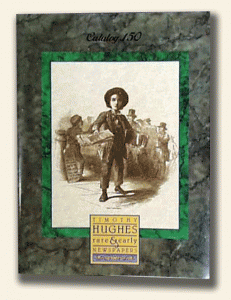 Cherokee Phoenix & Indians’ Advocate, New Echota, Georgia, Dc. 23, 1830 Very rare Cherokee newspaper. $155
Cherokee Phoenix & Indians’ Advocate, New Echota, Georgia, Dc. 23, 1830 Very rare Cherokee newspaper. $155
New York Herald, Jan. 3, 1863 Printing of the Emancipation Proclamation. $115
Gazette, Paris, 1635 $68
Niles’ Weekly Register, April 16, 1836 Battle of the Alamo. $135
As much as you might like to buy these newspapers at these prices I’d like to have them back. Their values have increased dramatically through the years.
By the way, many of our old catalogs, going back to our very first, are available for purhase. Inquire.
Waiting to be discovered…
February 9, 2009 by TimHughes · Leave a Comment
The History Channel has sparked much interest in events of the past which otherwise have gone unnoticed through the years. Whether it’s a biography of notable name, a little-known yet significant war battle, or a political event which had notable consequences years later, it’s not uncommon for us to receive calls from hopeful collectors wanting a period account of the event. Many times we are successful in the search, other times not.
Occasionally present-day events noting an anniversary or discovery spark similar interest. We have noticed a significant interest in Abraham Lincoln material with the approach of the 200th anniversary of his birth. And the very recent discovery of the British ship “H.M.S. Victory” got even us intrigued about the possibility of finding a 1744 newspaper or magazine reporting its loss.
As a bit of background, a report dated February 5, 2009 from the “Best Syndication News” service brought this event into the 21st century with its breaking news reading:
“The HMS Victory ship sunk in stormy seas back in 1744 but it wasn’t until this week, when an American company called Odyssey discovered what they call “the most significant shipwreck discovery in history.” The HMS Victory was a warship that had a crew of around 1,100 that died when it went underwater. The estimated treasures with gold coins and artifacts could be worth potentially $1 billion. The Odyssey company is undergoing a legal battle to allow them to recover the treasures and artifacts. Because the HMS Victory is a military ship she is the property of the British government according to the laws of marine salvaging.”
As luck would have it we were successful. Keeping in mind that there were no survivors, details were obviously sketchy back then, but both the October and November issues of the “Gentleman’s Magazine” reflected upon the disaster.
All of us, as collectors, literary keep history on our shelves. Who knows when the next discovery might relate to an innocuous report in one of your newspapers. Have you discovered in one of your issues an item brought to light by present-day events? Such finds are always fascinating–it’s part of the intrigue of the hobby.



